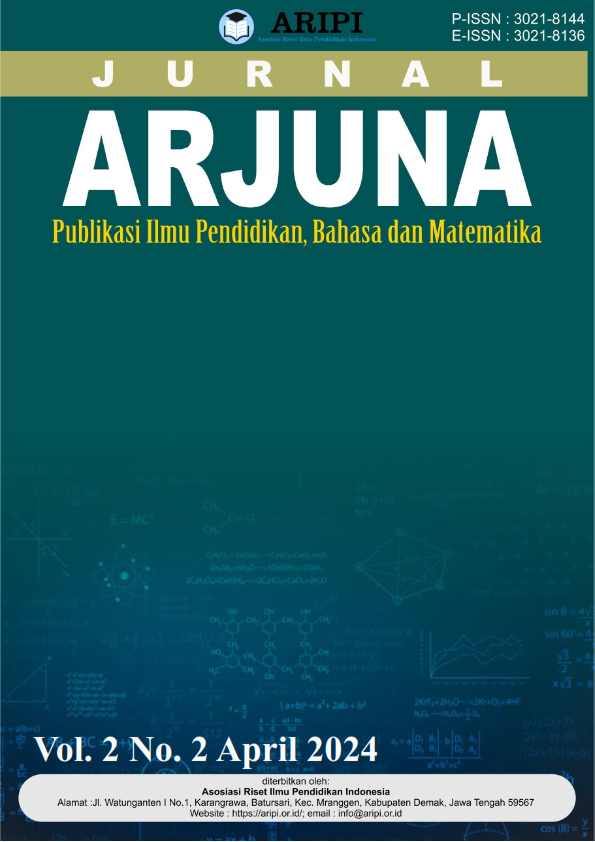Analisis Kemampuan Pemecahan Masalah Mahasiswa Dalam Matakuliah Matematika Diskrit Pada Materi Fungsi
DOI:
https://doi.org/10.61132/arjuna.v2i2.702Keywords:
Problem Solving Ability, Polya, radial basis function networkAbstract
Problem solving ability is one of the problems still faced in mathematics learning. Problem solving abilities function as a learning method to train and support problem solving abilities in mathematics problems. The aim of this research is to describe the level of students’ problem solving abilities based on the polya procedure. Judging from the stages of understanding the problem, planning, implementing planning, and looking back. This type of research is descriptive research with a qualitative approach. Data collection using problem solving ability tests and interviews. The research was conducted on third semester Informatics engineering students at Stella Maris University, Sumba. The result of the research results of the problem solving ability test were included in the quite good category. There are several factors that become obstacles for students, namely (1) the process of solving questions is not coherent and does not match the steps for solving the problem, (2) some students are confused about identifying elements that are known and asked about and, (3) in learning students tend to remain silent when found difficulty in solving the questions given..
Downloads
References
Astutiani, R., Isnarto, & Hidayah, I. (2019). Kemampuan Pemecahan Masalah Matematika Kelas VIII Berdasarkan Gaya Belajar Siswa. Paedagoria: Jurnal Kajian, Penelitian dan Pengembangan Kependidikan, 11 (03).
Candra, U. D. (2020). Analisis Kesalahan Peserta Didik SMA Kelas X dalam Menyelesaikan Soal Cerita Berdasarkan Langkah Polya pada Materi Sistem Persamaan Linear. Lampung: Universitas Islam Negeri Raden Intan Lampung.
Febriani, S. & Najibufahmi, M,. (2022). Analisis Pemecahan Masalah Berdasarkan Langkah Polya Ditinjau dari Prestasi Belajar Siswa Kelas VIII Sekolah Menengah. Prosiding Konferensi Ilmiah Pendidikan, 03 (2022), 25 – 42
Karin, Abdul dan Afatin Nurrahmah. (2018). Analisis Kemampuan Pemahaman Matematis Mahasiswa pada Mata Kuliah Teori Bilangan. Jurnal Analisa 4 (1), 179 – 187.
Kartika, M., & Hiltrimartin, C. (2019). Penerapan Model Eliciting Activities Pendidikan Matematika Raflesia, 04 (02), 15-28.
Muliawati, Fatikha N., dan Sutirna. (2022). Analisis Kemampuan Pemecahan Masalah Matematis Siswa pada Materi Relasi dan Fungsi. Jurnal Pendidikan Matematika, 06 (01), 32 – 42.
Polya, G. (1945). How to Solve It. How to Solve It, 1-4. Https://doi.org/10.1515/9781400828678
Polya, G. (1973). How to Solve It: a new aspect of mathematical method second edition. In the Mathematical Gazette (Vol. 30, p. 181). Https://www.jastor.org/stable/3509122?origin=creossref
Qudsiyah, Khoirul. (2021). Pemahaman Konsep dalam Menyelesaikan Masalah Logika Mahasiswa Pendidikan Matematika STKIP PGRI Pacitan. Pro.
Sugiyono. (2011). Metode Penelitian kuantitatif Kualitatif Dan R&D. Bandung: Alfabeta Pelajar.
Triyani, E., & Pujiastuti, H. (2020). Analisis Kemampuan Pemecahan Masalah Mahasiswa dalam Mata Kuliah Matematika Dikrit pada Materi Kombinatorika. AdMathEdu. 10 (02), 77 – 90.
Downloads
Published
How to Cite
Issue
Section
License
Copyright (c) 2024 Jurnal Arjuna : Publikasi Ilmu Pendidikan, Bahasa dan Matematika

This work is licensed under a Creative Commons Attribution-ShareAlike 4.0 International License.






